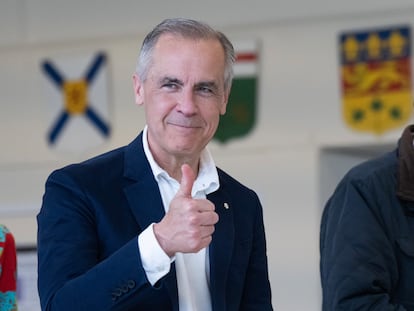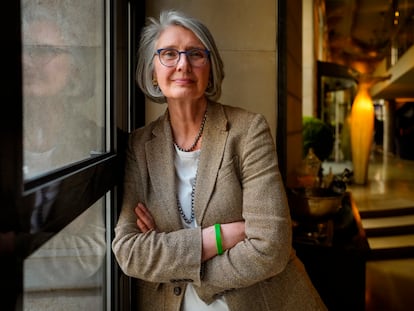Carney says Canada is ‘not for sale’ and Trump replies: ‘Never say never’
The Canadian leader has visited the White House for the first time following his election victory, marked by tensions with Washington

There were no public arguments or insults. On the contrary, the first meeting between U.S. President Donald Trump and Canadian Prime Minister Mark Carney proceeded with utmost politeness. However, the underlying disagreements over tariffs, trade relations, and Trump’s interest in annexing Canada were laid bare, perhaps even more clearly than if the two had started shouting at each other. Gently but firmly, the former central banker of Canada and the U.K. settled the issue of Canadian sovereignty: “There are places that are simply not for sale... [Canada] is not for sale. It won’t be for sale.” In response, Trump quipped: “Never say never.”
Neither the United States nor Canada had high expectations for this Tuesday’s meeting in the Oval Office. “Don’t expect white smoke,” Carney warned before the meeting.
The first meeting between the two was supposed to serve as a way to gauge the situation, as relations between the two neighbors, partners, and once almost mimetic allies, are at their lowest point in recent history. Trump demands that Canada become another state of the U.S. and wants to crush it with tariffs; while Carney’s Liberal Party won last week’s election in Canada thanks to the sharp anti-Trump shift of an electorate that, just a few months ago, had decisively supported the Conservatives.
Canada is — or was, until Trump returned to the White House — the United States’s second-largest trading partner and its closest ally in a wide range of areas, from the economy and intelligence sharing, to academic collaboration and to national security. But the imposition of tariffs and the Republican’s statements calling for Canada to become part of the United States have shattered that idyllic relationship. Carney himself made this clear upon taking office: “The old relationship we had with the United States, based on deepening integration of our economies and tight security and military cooperation, is over.”
And immediately before welcoming Carney to the West Wing of the White House, Trump — who for months ridiculed Carney’s predecessor, Justin Trudeau, referring to him as “Governor Trudeau” — took to social media to fire back and set the tone for their meeting.
“We don’t need their Cars, we don’t need their Energy, we don’t need their Lumber, we don’t need ANYTHING they have, other than their friendship, which hopefully we will always maintain,” he wrote. “They, on the other hand, need EVERYTHING from us!”
Only 9% of Canadians support becoming part of the United States, while 85% flatly reject the idea, according to a March survey conducted by the pollster Leger. In response to growing tensions, many Canadians have begun boycotting U.S. consumer goods in favor of imports from other countries. Canadian tourism to the U.S. has dropped sharply, and the country’s new government is actively working to strengthen ties with other nations — particularly in Europe — in an effort to reduce reliance on Washington.
Following his victory in the April 28 election, Carney declared: “We are over the shock over American betrayal. But we will never forget the lessons.” He continued: “America wants our land, our resources, our water, our country. These are not idle threats. President Trump is trying to break us so America can own us. That will never, ever happen.”
The two nations are members of the United States-Mexico-Canada Agreement (USMCA), the successor to the Clinton-era NAFTA. USMCA was renegotiated during Trump’s first term and ratified in 2020. However, in early March — despite efforts at negotiations and diplomatic gestures — the White House imposed 25% tariffs on imports from Canada and Mexico. These were briefly suspended after Trudeau and Mexican President Claudia Sheinbaum pledged stronger efforts to combat fentanyl trafficking across their respective borders.
Currently, 25% U.S. tariffs remain on goods outside the scope of the USMCA, including steel and aluminum. Canadian softwood lumber faces a 14.54% tariff. In retaliation, Canada imposes a 25% tariff on roughly $22 billion worth of U.S. goods — from orange juice to home appliances — and an additional 25% on another $22 billion worth of metal imports. It also penalizes U.S. vehicles that do not meet USMCA requirements with a 25% tariff.
Before Tuesday’s face-to-face meeting, Carney and Trump spoke by phone at least twice since Carney succeeded Justin Trudeau as Liberal Party leader in March — the most recent call coming just one day after Carney’s election win. Both governments described the conversations as “constructive.” “I think we’re going to have a great relationship,” Trump said on April 29, following their latest call.
Tariffs were expected to dominate the agenda in the Oval Office, the tone of the meeting was surrounded by less pageantry than Trump’s previous encounters with world leaders like French President Emmanuel Macron or British Prime Minister Keir Starmer.
On Monday, U.S. Commerce Secretary Howard Lutnick told Fox Business that a new trade agreement with Canada was “possible,” but warned that it’s “really complex.”
Canada is the largest buyer of U.S. exports, importing nearly $394.4 billion worth of goods ranging from energy and automobiles to agricultural products. Meanwhile, the U.S. is Canada’s biggest trade partner, absorbing about three-quarters of Canadian exports — primarily steel, aluminum, and lumber.
Sign up for our weekly newsletter to get more English-language news coverage from EL PAÍS USA Edition
Tu suscripción se está usando en otro dispositivo
¿Quieres añadir otro usuario a tu suscripción?
Si continúas leyendo en este dispositivo, no se podrá leer en el otro.
FlechaTu suscripción se está usando en otro dispositivo y solo puedes acceder a EL PAÍS desde un dispositivo a la vez.
Si quieres compartir tu cuenta, cambia tu suscripción a la modalidad Premium, así podrás añadir otro usuario. Cada uno accederá con su propia cuenta de email, lo que os permitirá personalizar vuestra experiencia en EL PAÍS.
¿Tienes una suscripción de empresa? Accede aquí para contratar más cuentas.
En el caso de no saber quién está usando tu cuenta, te recomendamos cambiar tu contraseña aquí.
Si decides continuar compartiendo tu cuenta, este mensaje se mostrará en tu dispositivo y en el de la otra persona que está usando tu cuenta de forma indefinida, afectando a tu experiencia de lectura. Puedes consultar aquí los términos y condiciones de la suscripción digital.
More information
Archived In
Últimas noticias
All the effects of gentrification in one corner of Mexico’s Colonia Roma
Palestinian reporter Youmna El Sayed: ‘My family told me I had to choose between being a journalist or a mother’
The new language of the workplace: Knowing how to ask AI questions is more important than using it
Russell Tovey: ‘I was advised many times not to come out, I don’t think there was many people who’d done that — and I feel really proud that I’m one of those that did’
Most viewed
- The low-cost creative revolution: How technology is making art accessible to everyone
- Christian Louboutin: ‘Young people don’t want to be like their parents. And if their parents wear sneakers, they’re going to look for something else’
- US sanctions against jailed cartel leader ‘El Marro’ highlight Mexico’s lack of control over its prisons
- Liset Menéndez de la Prida, neuroscientist: ‘It’s not normal to constantly seek pleasure; it’s important to be bored, to be calm’
- Cartels in Mexico take a leap forward with narco-drones: ‘It is criminal groups that are leading the innovation race’











































